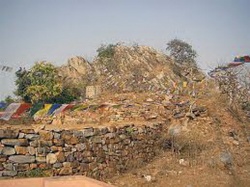Difference between revisions of "Eagle Peak"
| Line 4: | Line 4: | ||
[[霊鷲山]]・[[耆闍崛山]]・[[霊山]] (Skt [[Gridhrakuta]]; [[Pali]] [[Gijjha-kuta]]; Jpn [[Ryoju-sen]], [[Gishakussen]], or [[Ryo-zen]]) | [[霊鷲山]]・[[耆闍崛山]]・[[霊山]] (Skt [[Gridhrakuta]]; [[Pali]] [[Gijjha-kuta]]; Jpn [[Ryoju-sen]], [[Gishakussen]], or [[Ryo-zen]]) | ||
| − | Also known as [[Vulture Peak]], [[Holy Eagle Peak]], or [[Sacred Eagle Peak]], and simply [[Holy Mountain]], [[Sacred Mountain]], or[[ Holy Peak]]. A small mountain located north-east of [[Rajagriha]], the {{Wiki|capital}} of [[Magadha]] in {{Wiki|ancient}} {{Wiki|India}}. [[Eagle Peak]] is known as a place frequented by [[Shakyamuni]], where he is said to have expounded the [[Lotus Sutra]] and other teachings. According to The [[Treatise on the Great Perfection of Wisdom]] by [[Nagarjuna]], [[Eagle Peak]] derived its [[name]] from its eagle-shaped | + | Also known as [[Vulture Peak]], [[Holy Eagle Peak]], or [[Sacred Eagle Peak]], and simply [[Holy Mountain]], [[Sacred Mountain]], or[[ Holy Peak]]. A small mountain located north-east of [[Rajagriha]], the {{Wiki|capital}} of [[Magadha]] in {{Wiki|ancient}} {{Wiki|India}}. [[Eagle Peak]] is known as a place frequented by [[Shakyamuni]], where he is said to have expounded the [[Lotus Sutra]] and other teachings. According to The [[Treatise on the Great Perfection of Wisdom]] by [[Nagarjuna]], [[Eagle Peak]] derived its [[name]] from its eagle-shaped summit and the many eagles or vultures inhabiting it. "[[Eagle Peak]]" also [[symbolizes]] the [[Buddha land]] or the state of [[Buddhahood]], as in the expression "the [[pure land]] of [[Eagle Peak]]." |
See also; [[Gridhrakuta]]. | See also; [[Gridhrakuta]]. | ||
Latest revision as of 12:25, 14 December 2013
Eagle Peak
霊鷲山・耆闍崛山・霊山 (Skt Gridhrakuta; Pali Gijjha-kuta; Jpn Ryoju-sen, Gishakussen, or Ryo-zen)
Also known as Vulture Peak, Holy Eagle Peak, or Sacred Eagle Peak, and simply Holy Mountain, Sacred Mountain, orHoly Peak. A small mountain located north-east of Rajagriha, the capital of Magadha in ancient India. Eagle Peak is known as a place frequented by Shakyamuni, where he is said to have expounded the Lotus Sutra and other teachings. According to The Treatise on the Great Perfection of Wisdom by Nagarjuna, Eagle Peak derived its name from its eagle-shaped summit and the many eagles or vultures inhabiting it. "Eagle Peak" also symbolizes the Buddha land or the state of Buddhahood, as in the expression "the pure land of Eagle Peak."
See also; Gridhrakuta.
